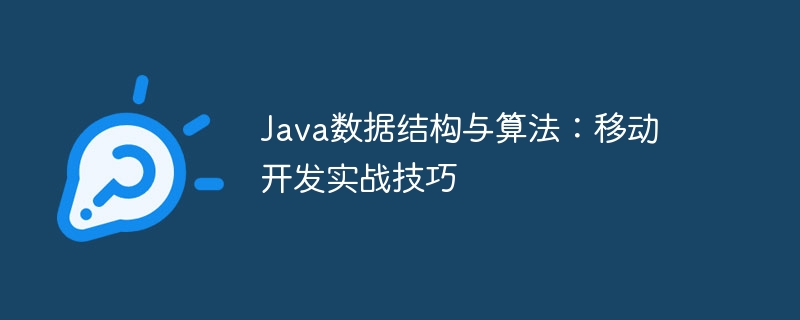
Data structures and algorithms are crucial in mobile development and help build efficient applications. Common practical data structures include linked lists and queues, which are suitable for scenarios such as contact lists and message queues. Sorting algorithms (such as sorting contacts by name) and search algorithms (such as binary search) process data efficiently. By selecting and using appropriate data structures and algorithms, developers can significantly improve mobile application performance and user experience.

Data structures and algorithms are crucial in mobile development and can help developers build efficient, Responsive application. This article will explore some common practical data structures and algorithms in mobile development and illustrate them through practical cases.
Linked list
A linked list is a linear data structure in which elements are organized together in the form of links. Each element has a reference to the next element. Linked lists can remain efficient as elements are added or removed.
Practical case: Contact list
// 链表节点类
public class Contact {
private String name;
private String phoneNumber;
private Contact next;
}
// 主类
public class ContactList {
private Contact head;
public void addContact(String name, String phoneNumber) {
Contact newContact = new Contact();
newContact.setName(name);
newContact.setPhoneNumber(phoneNumber);
// 将新节点添加到链表头部
newContact.setNext(head);
head = newContact;
}
public Contact findContact(String name) {
Contact current = head;
while (current != null) {
if (current.getName().equals(name)) {
return current;
}
current = current.getNext();
}
return null;
}
}Queue
The queue is a first-in-first-out (FIFO) data structure. Elements enter from one end of the queue and leave from the other end. Queues are suitable for processing tasks or requests.
Practical case: Message queue
// 队列类
public class MessageQueue {
private Queue<Message> queue;
public void addMessage(Message message) {
queue.add(message);
}
public Message getNextMessage() {
return queue.poll();
}
}
// 主类
public class MessageProcessor {
private MessageQueue queue;
public void start() {
while (true) {
Message message = queue.getNextMessage();
if (message != null) {
// 处理消息
}
}
}
}Sort algorithm
The sort algorithm can sort elements Arranged in some order. In mobile development, efficient sorting algorithms are needed to handle large amounts of data.
Practical case: Contacts sorted by name
// 排序联系人
Collections.sort(contacts, new Comparator<Contact>() {
@Override
public int compare(Contact o1, Contact o2) {
return o1.getName().compareTo(o2.getName());
}
});Search algorithm
Search algorithm is used in a set of data Find specific elements. In mobile development, efficient search algorithms are needed to find information quickly.
Practical Case: Binary Search for Contacts
int index = Collections.binarySearch(contacts, targetContact, new Comparator<Contact>() {
@Override
public int compare(Contact o1, Contact o2) {
return o1.getName().compareTo(o2.getName());
}
});
if (index >= 0) {
// 找到联系人
}In mobile development, selecting and using appropriate data structures and algorithms is crucial to building efficient, scalable and user-friendly Application is crucial. By understanding these basic concepts and applying them through real-world examples, developers can significantly improve the performance and user experience of their mobile applications.
The above is the detailed content of Java Data Structures and Algorithms: Practical Tips for Mobile Development. For more information, please follow other related articles on the PHP Chinese website!
